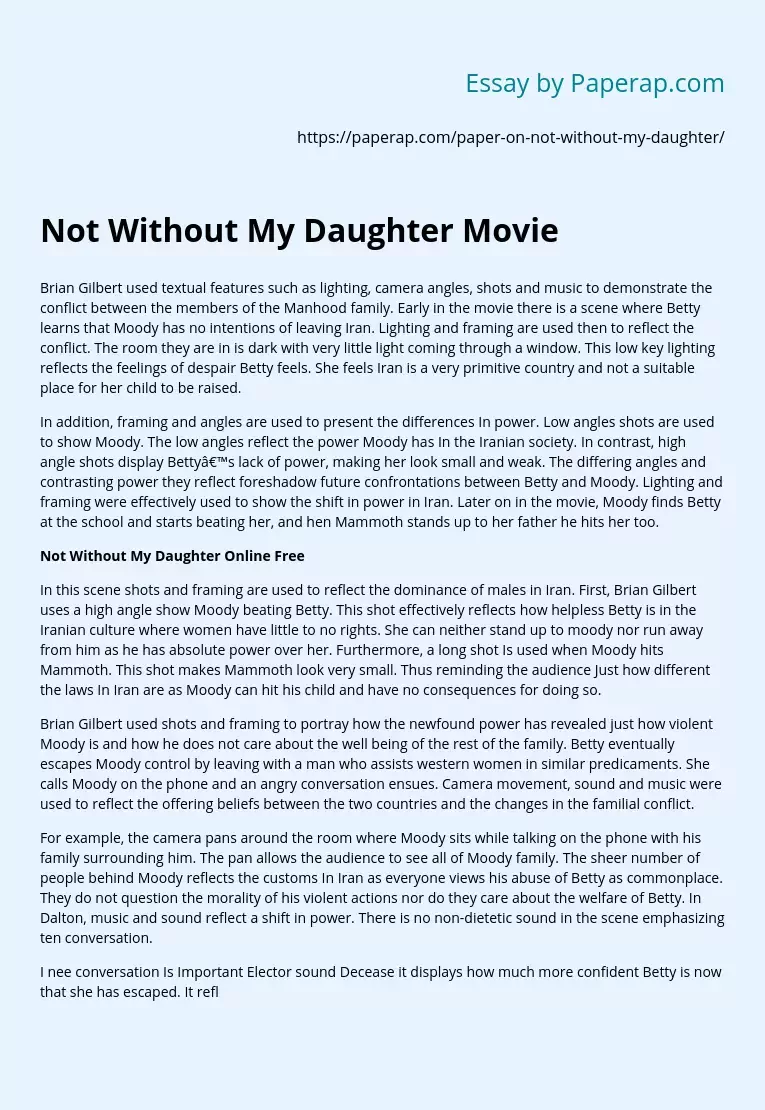Not Without My Daughter Movie
Brian Gilbert used textual features such as lighting, camera angles, shots and music to demonstrate the conflict between the members of the Manhood family. Early in the movie there is a scene where Betty learns that Moody has no intentions of leaving Iran. Lighting and framing are used then to reflect the conflict. The room they are in is dark with very little light coming through a window. This low key lighting reflects the feelings of despair Betty feels. She feels Iran is a very primitive country and not a suitable place for her child to be raised.
In addition, framing and angles are used to present the differences In power. Low angles shots are used to show Moody. The low angles reflect the power Moody has In the Iranian society. In contrast, high angle shots display Betty’s lack of power, making her look small and weak. The differing angles and contrasting power they reflect foreshadow future confrontations between Betty and Moody.
Lighting and framing were effectively used to show the shift in power in Iran. Later on in the movie, Moody finds Betty at the school and starts beating her, and hen Mammoth stands up to her father he hits her too.
Not Without My Daughter Online Free
In this scene shots and framing are used to reflect the dominance of males in Iran. First, Brian Gilbert uses a high angle show Moody beating Betty. This shot effectively reflects how helpless Betty is in the Iranian culture where women have little to no rights.
She can neither stand up to moody nor run away from him as he has absolute power over her. Furthermore, a long shot Is used when Moody hits Mammoth. This shot makes Mammoth look very small. Thus reminding the audience Just how different the laws In Iran are as Moody can hit his child and have no consequences for doing so.
Brian Gilbert used shots and framing to portray how the newfound power has revealed just how violent Moody is and how he does not care about the well being of the rest of the family. Betty eventually escapes Moody control by leaving with a man who assists western women in similar predicaments. She calls Moody on the phone and an angry conversation ensues. Camera movement, sound and music were used to reflect the offering beliefs between the two countries and the changes in the familial conflict.
For example, the camera pans around the room where Moody sits while talking on the phone with his family surrounding him. The pan allows the audience to see all of Moody family. The sheer number of people behind Moody reflects the customs In Iran as everyone views his abuse of Betty as commonplace. They do not question the morality of his violent actions nor do they care about the welfare of Betty. In Dalton, music and sound reflect a shift in power. There is no non-dietetic sound in the scene emphasizing ten conversation.
I nee conversation Is Important Elector sound Decease it displays how much more confident Betty is now that she has escaped. It reflects the differences in roles of woman between American and Iranian culture as Betty is completely different when she no longer has to fear being beaten by Moody. She is now able to make her own decisions and choices. Music, sounds and camera movement were used in this scene to reflect the Iranians view of the conflict and how Betty and Mammoth’s freedom changed the conflict.
In movies small things like the angle of a shot or the lighting of a scene can change the mood and interpretation of a scene. These subtle features were all used effectively in Not Without My Daughter to demonstrate a cultural conflict within the Manhood family. Each scene demonstrated different aspects of the familial conflict providing a clear image of how different the cultures Iran and America are. These differences not only affect familial relationships as demonstrated in the film, but also relations between the two countries.
Not Without My Daughter Movie. (2019, Dec 05). Retrieved from https://paperap.com/paper-on-not-without-my-daughter/

